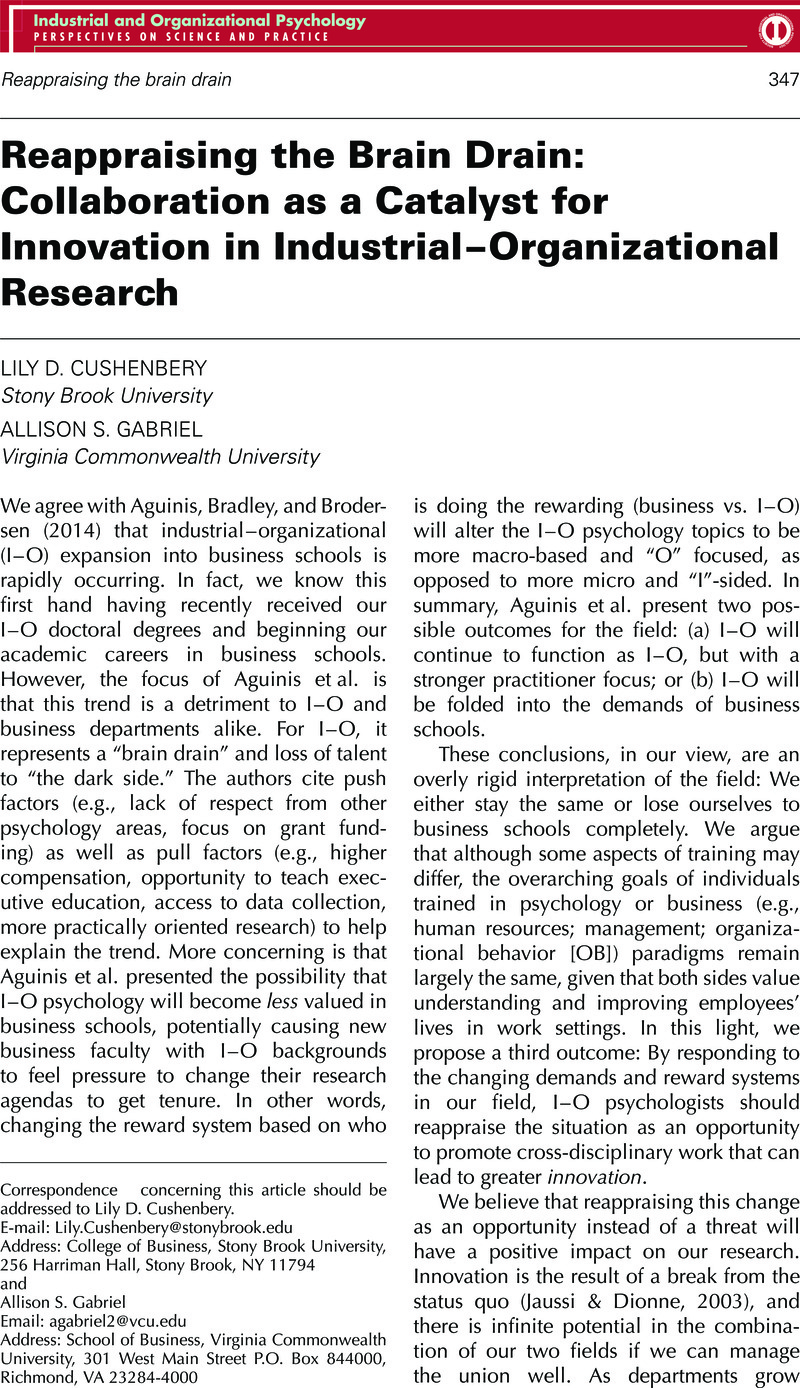No CrossRef data available.
Article contents
Reappraising the Brain Drain: Collaboration as a Catalyst for Innovation in Industrial–Organizational Research
Published online by Cambridge University Press: 07 January 2015
Abstract
An abstract is not available for this content so a preview has been provided. Please use the Get access link above for information on how to access this content.

- Type
- Commentaries
- Information
- Copyright
- Copyright © Society for Industrial and Organizational Psychology 2014
References
Aguinis, H., Bradley, K. J., & Brodersen, A. (2014). Industrial–organizational psychologists in business schools: Brain drain or eye opener? Industrial and Organizational Psychology: Perspectives on Science and Practice, 7(3), 284–303.Google Scholar
Amabile, T. M., Hennessey, B. A., & Grossman, B. S. (1986). Social influences on creativity: The effects of contracted-for reward. Journal of Personality and Social Psychology, 50(1), 14–23.Google Scholar
Anderson, N., & West, M. (1998). Measuring climate for work group innovation: Development and validation of the team climate inventory. Journal of Organizational Behavior, 19(3), 235–258.Google Scholar
Bain, P., Mann, L., & Pirola-Merlo, A. (2001). The innovation imperative: The relationships between team climate, innovation, and performance in research and development teams. Small Group Research, 32(1), 55–73. doi: 10.1177/104649640103200103CrossRefGoogle Scholar
Bledow, R., Frese, M., Anderson, N., Erez, M., & Farr, J. L. (2009). A dialectic perspective on innovation: Conflicting demands, multiple pathways, and ambidexterity. Industrial and Organizational Psychology, 2, 305–337.CrossRefGoogle Scholar
Elkins, T., & Keller, R. T. (2003). Leadership in research and development organizations: A literature review and conceptual framework. The Leadership Quarterly, 14, 587–606. doi: 10.1016/S1048-9843(03)00053-5CrossRefGoogle Scholar
Erez, M., & Gati, E. (2004). A dynamic, multi-level model of culture: From the micro level of the individual to the macro level of a global culture. Applied Psychology: An International Review, 53(4), 583–598.Google Scholar
Folkestad, J., & Gonzalez, R. (2010). Teamwork for innovation: A content analysis of the highly read and highly cited literature on innovation. Advances in Developing Human Resources, 12(1), 115–136. doi: 10.1177/1523422310365486CrossRefGoogle Scholar
Gilson, L. L., & Shalley, C. E. (2004). A little creativity goes a long way: An examination of teams' engagement in creative processes. Journal of Management, 30(4), 453–470. doi: 10.1016/j.jm.2003.07.001CrossRefGoogle Scholar
Grant, A. (2013). The gift we love to receive but forget to give. Huffington Post. Retrieved from http://www.huffingtonpost.com/adam-grant/the-gift-we-love-to-recei_b_4342794.htmlGoogle Scholar
Hülsheger, U. R., Anderson, N., & Salgado, J. F. (2009). Team-level predictors of innovation at work: A comprehensive meta-analysis spanning three decades of research. Journal of Applied Psychology, 94(5), 1128–1145. doi: 10.1037/a0015978CrossRefGoogle Scholar
Hunter, S. T., & Cushenbery, L. (2011). Leading for innovation: Direct and indirect influences. Advances in Developing Human Resources, 13(3), 248–265. doi: 10.1177/1523422311424263CrossRefGoogle Scholar
Hunter, S. T., Bedell-Avers, K. E., & Mumford, M. D. (2007). The typical leadership study: Assumptions, implications, and potential remedies. The Leadership Quarterly, 18(5), 435–446. doi: 10.1016/j.leaqua.2007.07.001Google Scholar
Jaussi, K. S., & Dionne, S. D. (2003). Leading for creativity: The role of unconventional leader behavior. The Leadership Quarterly, 14, 475–498.CrossRefGoogle Scholar
King, N., & Anderson, N. (1990). Innovation in working groups. In West, M. A. & Farr, J. L. (Eds.), Innovation and creativity at work (pp. 81–100). Chichester, England: Wiley.Google Scholar
Mumford, M. D., & Licuanan, B. (2004). Leading for innovation: Conclusions, issues, and directions. The Leadership Quarterly, 15, 163–171. doi: 10.1016/j.leaqua.2003.12.010CrossRefGoogle Scholar
Mumford, M. D., Scott, G. M., Gaddis, B., & Strange, J. M. (2002). Leading creative people: Orchestrating expertise and relationships. The Leadership Quarterly, 13(6), 705–750. doi: 10.1016/S1048-9843(02)00158-3CrossRefGoogle Scholar
Perry-Smith, J., & Shalley, C. (2003). The social side of creativity: A static and dynamic social network perspective. Academy of Management Journal, 28(1), 89–106.Google Scholar
Schneider, B., Goldstein, H. W., & Smith, D. B. (1995). The ASA framework: An update. Personnel Psychology, 48, 747–773. doi: 10.1111/j.1744-6570.1995.tb01780.xCrossRefGoogle Scholar
Shin, S., & Zhou, J. (2003). Transformational leadership, conservation, and creativity: Evidence from Korea. Academy of Management Journal, 46(6), 703–714.CrossRefGoogle Scholar
Tierney, P., Farmer, S. M., & Graen, G. B. (1999). An examination of leadership and employee creativity: The relevance of traits and relationships. Personnel Psychology, 52(3), 591–620. doi: 10.1111/j.1744-6570.1999.tb00173.xGoogle Scholar




